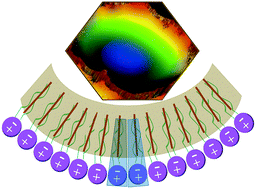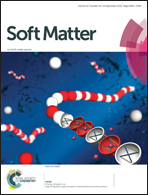Bending nematic liquid crystal membranes with phospholipids†
Abstract
The interactions of phospholipids with liquid crystals have formed the basis for attractive biosensor technologies, but many questions remain concerning the basic physics and chemistry of these interactions. Phospholipids such as 1,2-dilauroyl-sn-glycero-3-phosphocholine (DLPC), at sufficiently high (∼1 μM) concentrations and/or sufficiently long times, turn the liquid crystal director perpendicular to the LC/water interface. If the other side of the LC film is in contact with a surface that prefers perpendicular alignment, the LC film appears completely dark between crossed polarizers. Recently, however, Popov et al. (J. Mater. Chem. B, 2017, 5, 5061) noted that at even higher (∼10 μM) DLPC concentrations, the liquid crystal texture brightens again between crossed polarizers. To explain this surprising observation, it was suggested that the LC interface might bend. In this paper we show by optical surface profiler measurements that indeed the interface of the LC film of 4-cyano-4′-octylbiphenyl (8CB) suspended in a transmission electron microscopy (TEM) grid with openings of ∼0.5 mm in diameter bends towards the lipid-coated interface. We demonstrate that where the bending occurs, the bent interface exhibits extreme sensitivity to air pressure variations, producing an optical response with acoustic stimulation. Finally, we suggest a physical mechanism for this astonishing result.



 Please wait while we load your content...
Please wait while we load your content...